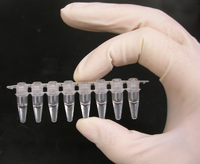Polymerase chain reaction

Okay little one, have you ever heard of DNA? It's like a blueprint for living things. Scientists use a method called Polymerase Chain Reaction (PCR) to make copies of this blueprint so they can study it.
Imagine a jigsaw puzzle, but you only have a few pieces. How would you complete the puzzle? You could make lots of copies of those few pieces and put them together to complete the puzzle, right? That's what PCR does with DNA!
First, we need some DNA to copy. We take some cells, like from your cheek or hair, and break them open to get the DNA. We then mix the DNA with some special molecules called primers, which are like puzzle pieces that only match to certain parts of the DNA. The primers tell a special machine called the PCR machine where to start copying the DNA.
Next, the PCR machine adds a special enzyme called polymerase that acts like a chef, adding little building blocks called nucleotides to the DNA. The nucleotides are like the ingredients needed to make a recipe. The machine heats and cools the mixture over and over again to melt the DNA and then cool it down so that the primers and polymerase can make copies of it. Each time it cycles through heating and cooling, the number of copies doubles until there are millions of copies!
So just like making lots of copies of puzzle pieces, PCR makes lots and lots of copies of the DNA blueprint, so scientists can study it and learn new things about living things!
Imagine a jigsaw puzzle, but you only have a few pieces. How would you complete the puzzle? You could make lots of copies of those few pieces and put them together to complete the puzzle, right? That's what PCR does with DNA!
First, we need some DNA to copy. We take some cells, like from your cheek or hair, and break them open to get the DNA. We then mix the DNA with some special molecules called primers, which are like puzzle pieces that only match to certain parts of the DNA. The primers tell a special machine called the PCR machine where to start copying the DNA.
Next, the PCR machine adds a special enzyme called polymerase that acts like a chef, adding little building blocks called nucleotides to the DNA. The nucleotides are like the ingredients needed to make a recipe. The machine heats and cools the mixture over and over again to melt the DNA and then cool it down so that the primers and polymerase can make copies of it. Each time it cycles through heating and cooling, the number of copies doubles until there are millions of copies!
So just like making lots of copies of puzzle pieces, PCR makes lots and lots of copies of the DNA blueprint, so scientists can study it and learn new things about living things!
Related topics others have asked about:
